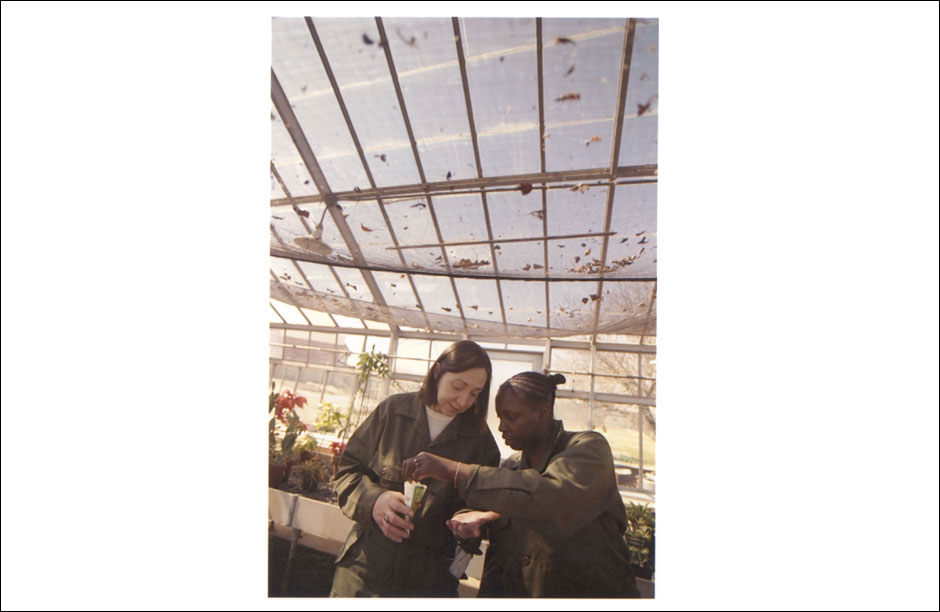In the Garden of Good and Legal
By Anna Sussman

From the corner of Freeman Street in the South Bronx, just under the subway station, the view encompasses three dilapidated churches, two delis, a Salvation Army thrift shop and a Puerto Rican restaurant. On a recent morning, one could also see a man in a straw hat supervising another man and woman busily planting beach grasses in dry, unpromising-looking dirt around trees in the sidewalk.
John Cannizzo, speaking from under the straw hat, explained that beach grass is uniquely suited to life in New York City. Used to brackish water, they’ll survive through winter when city workers scatter salt to melt snow. John, a self-taught gardener and former Peace Corps volunteer in Kenya, had two more employees upstairs, readying planting trays on a rooftop garden on the 7th floor of WHEDCo, a low-income housing development.
The duo downstairs, Stacey and Tara, are psychiatric patients in recovery, here thanks to a partnership between the Horticultural Society of New York (HSNY) and The Bridge, a New York-based charity that helps the mentally ill, homeless and substance abusers transition to independent living. The other two, Charlene and Aundrea, are ex-inmates of Rikers Island, New York’s famous prison. They, like Stacey and Tara, are making $7.50 to $10 an hour as interns with the GreenTeam, a jail-to-street program that begins at an elaborate greenhouse on Rikers Island.
In 1884, the City of New York bought the island from the Ryker family for $180,000, turning it into a farm to feed the city’s jail population. In 1936, a jail was built on the island, and since then, the island has continually shouldered various horticultural duties: hosting a nursery, farming for inmates, growing trees for the U.S. Forest Service. It still boasts New York City’s largest farm.
Prison horticulture dates back to the penitentiary movement established by Pennsylvania Quarters in the early 1800s. They promoted imprisonment as an alternative to execution or torture, and gave inmates work details to make the jails as self-sustaining as possible. Farm jobs had the triple benefit of providing fresh food, hard work and outdoor exposure, making for a more manageable inmate population.
Rikers maintained a six-to-eight acre vegetable garden on the island since 1981; in 1986, the HSNY, an organization whose original members included J.P. Morgan, began operating a greenhouse but closed it seven years later, after a grant from the city dried up. When Anthony Smith, a former city official in the David Dinkins administrations, became president of the HSNY in 1996, he reinstated the program. In “Doing Time in the Garden,” by James Jiler, who ran the GreenHouse Program from 1996 until 2008, Smith tells Jiler that the GreenHouse had to be more than just a feel-good activity.
“I want our students to have the skills so when they leave Rikers, they can find work in horticulture,” Smith insists.
It’s not as easy as it sounds – few prisoners, even ones who have received job training, have the contacts and interviewing skills to move directly into the job market. In the US, it is estimated that as many as half of the 2.3 million people currently in state, federal or local prison are functionally illiterate, and similarly high rates of mental illness prevail. For the past ten years, recidivism at Rikers has hovered above an appalling 60%, since many inmates return to their old neighborhoods and social circles, where trouble, in the form of a ready supply of drugs, or an abusive parent or partner, may be waiting to welcome them home.
According to Jiler, who is currently living in Miami where he’s replicating the GreenHouse and similar vocational training programs throughout Florida, state budget troubles have meant that corrections departments throughout the country have cut funding to these kinds of programs, even though prison-administered higher education has proven to be the single most effective way to reduce recidivism. He understands the rationale – why, people ask, do criminals get special treatment when services for ordinary citizens are being slashed? But to him, this question misses the point.
“We’re not just out there because we feel bad for these people who got arrested for drugs, or prostitution,” he says. “It’s about making communities healthier. How do you want your community to be when prisoners come back, and they’ve been treated like animals in jail?”
In his book, he writes, “Horticulture is a process that allows them to control their environment through shared responsibilities in an unspoken contract between person and plant.” All aspects of the process take on larger meaning: “Compost is used as a metaphor for life’s mistakes and misfortunes…weeding is equivalent to removing the negative thoughts…in one’s life, while transplanting and watering symbolize the stage of leaving jail and maintaining a productive life outside.”
The GreenTeam, now run single-handedly by John, provides the critical link between the gardeners and the private sphere. The team bids on gardening and landscaping projects – community gardens all around the Bronx and East Harlem, historical sites, Park Avenue terraces, library gardens – as a competitive business, and also partners with charities like United Way, which provided the grant for this project at WHEDCo.
Participants must simultaneously undertake other activities appropriate to their situation: drug rehabilitation therapy, maybe, a GED certificate, or psychiatric counseling. John keeps a watchful, caring eye trained on his roster of employees, usually around a dozen people at a time, checking in with their parole officers and arranging for supplementary work for them when he can. Compared to non-participants, GreenHouse and GreenTeam members have had a 12% recidivism rate, over the period from 2000 to 2007.
Aundrea, 51, is a large woman in baggy jeans. Arriving at Rikers in October 2008, she initially hadn’t wanted to work in the GreenHouse. Her first choice for inmate assignment was the bakery.
“It paid better,” she says simply, fifty-six dollars a week to bake, compared to sixteen for gardening. Her first task – weeding – was odious. Nevertheless, something bit.
“I guess you could say I just fell in love,” she remembers. “Everything was set up real nice there in the GreenHouse.”
From weeding, she learned to prune, and after serving five months in Rikers, she was ready for the GreenTeam. Her first day of work, she planted a vegetable garden at St. Vincent’s hospital.
“Carrots, collards, radishes, lettuce,” she ticks off. Two weeks later, she went back, and saw the vegetables beginning to sprout.
“My favorite part,” she says after some contemplation, “is when you see the results of what you’ve done. It’s a very, very rewarding feeling.”
Dr. Benjamin Rush, “the Father of American psychiatry,” pioneered horticultural therapy in the late 1800s as one of several occupational therapy activities he recommended for the patients he treated in his Philadelphia hospital. A century and a half later, its use swelled in America in treating hospitalized veterans returning from World War II. A 2007 position paper by the American Horticultural Therapy Association lists the numerous cognitive, psychological, social, and physical benefits it can have, among them an increased sense of self-worth, improved memory capacity, and improved immune response. In the preface to “Restorative Commons: Creating Health and Well-being through Urban Landscapes,” Oliver Sacks, the physician and author, writes that “hortophilia, the desire to interact with, manage and tend nature, is…deeply instilled in us.” Nature’s effects, he says, “are not only spiritual and emotional, but physical and neurological.”
Tara is wearing a black sleeveless t-shirt and jeans rather too large for her. She’s 43, and has silvery-white hair cut short at the front, with a longer part in the back that flows in the wind behind her neck. She grew up in Levittown, Long Island, surrounded by fruit trees: blackberry, apple, pear, crab apple, wild raspberries. Her mother tended roses and flowers, “stuff I’m not really interested in,” she says.
She became addicted to drugs, spiraling downwards until, as she puts it, “I really fucked up my life.” At Rikers, she lost her eligibility to participate in the GreenHouse, after a dust-up with some inmates she thought were making fun of her. For the past five years, she has been under court-ordered mental observation. She’s been gardening with John for three seasons, as part of a job-training program offered by The Bridge.
“Rather than talking all day, I like doing. I like feeling like I get something done,” she says. “It has come to be a joy to me. Instead of going around in circles and wandering around Manhattan.”
Tara is thoughtful and concerned, someone for whom growing vegetables has led to deep anxiety over larger issues of food inequality. She was a vegetarian for fifteen years (“I really enjoyed food then,” she says. “Every time I sat down to eat, it was like, Wow, you become part of a world that’s really real.”) But now, living in a supervised community residence, she eats what’s put in front of her.
“I try not to be too picky, you know?” she says sweetly.
Discussing hunger and malnutrition, she refers over and over to a scene from a movie that haunts her: a starving child pulling a rat out of a sewer to eat. But her solutions – she seems to believe she is obliged to solve these problems on her own – gesture at a residue of the paranoia and psychosis that plagued her past. As she talks, a number of plans and fears emerge, which include the shipping of food to Africa, the possibility that seeds in irradiated produce will never reproduce, setting up food donation bins around town (she repeatedly mentions coconuts, tuna and beans), and trying to get people to stop eating chickens so as to give them a chance to lay eggs.
John takes it one day at a time with his employees. Tara, he said, is much more even-tempered than when he met her three years ago. He appears to have limitless patience with all of his charges, gently weaving a lesson into each task, from how to dig dirt to the right way to fill up a wheelbarrow, never raising his voice.
Later in the afternoon, as Aundrea and Charlene plant the last few beach grasses, he explains how plants live and breathe in different two environments – soil and oxygen – unlike humans, say, or fish. Furthermore, plants have the ability to create atmosphere, he stresses, unlike humans, who take in oxygen and emit carbon dioxide.
Aundrea does not appear terribly interested in John’s philosophizing today. But she and Charlene work together carefully, Aundrea digging holes while Charlene brings a plant from the wheelbarrow and places it in the ground, securing it by patting dirt around it.
“If I come back and see this all grass green,” Aundrea says, gesturing to the dry, yellowish tufts around her, “that would be my thrill. Because plants don’t respond to everybody,” she states. “But they like me.”
She pauses for a moment, and laughs at herself.
“That’s not a brag,” she clarifies. “That’s a fact.”
